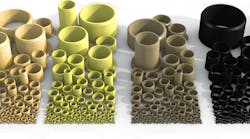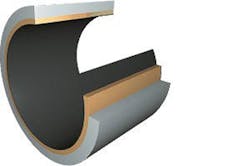Some engineers are hesitant about using plastic bearings in their designs. Many of them, having trusted metal and bronze bearings for years, don’t feel the need to make a switch. Others are simply under the impression that plastics aren’t capable of handling tough applications or severe and harsh environments. Plastic bearings, however, can withstand extreme temperatures, heavy loads, and high speeds. Thus, it is important for engineers to understand the advantages and disadvantages of all their material options.
Metal Standbys
Metal-backed, PTFE-lined (polytetrafluorethylene) bearings have a steel backing bonded to a porous bronze sinter layer overlaid with a PTFE lining. The lining can be scratched off by contaminates, which results in metal-to-metal contact between the bearing and shaft. This increases the coefficient of friction (COF), accelerates wear rates, and increases the risk of shaft damage.
When sintered-bronze bearings rotate on the shaft (minimum speed of 200 fpm), oil from the bearing is extracted. The oil creates a thin film that separates the bearing and the shaft, preventing wear and damage. At high speeds, the oil also creates a low COF between the shaft and the bearing. However, shaft oscillation, slow speeds, irregular use, or uneven loads can disrupt the thin film and therefore increase the COF and wear rates.
The Plastic Alternative
Self-lubricating polymer bearings have solid lubricants embedded in millions of chambers throughout the entire wall thickness. When the shaft spins, lubricant from plastic bearings gets transferred onto the shaft, creating an ideal mating surface and a low COF. Unlike sintered-bronze bushings, polymer bearings release solid lubricants as soon as the shaft begins to move. The fiber-reinforcing materials inside the bearing withstand high forces and edge loads. Plastic bearings can also be used on many different types of shafts, allowing for an overall cost savings.
It is also important not to confuse high-performance plastic bearings with plastic bearings from local injection molders. With some high-performance plastic bearings—such as those from igus—engineers can accurately calculate their service life according to wear rates, actual testing results, and specific application parameters.
Here are five major benefits of engineered plastic bearings:
- Freedom from maintenance. Plastic bushings can replace bronze, metal-backed, and simple plastic injection-molded bearings in almost any application. They resist dirt, dust, and chemicals, making them a “fit-and-forget” component.
- Cost savings. Plastic bushings reduce overall costs by up to 40%. They resist wear, allow for inexpensive shafts, reduce maintenance costs, and can replace more costly alternatives in a variety of applications.
- No messy lubricants. Self-lubricating bearings need no additional lubricants, saving time and eliminating the need for frequent servicing.
- Consistent coefficients of friction. Plastic bearings maintain a constant and low COF over their lifetimes. Unlike metal-backed bearings, which can become worn and increase the COF, plastic bearings often have very long service lives.
- Corrosion resistance. Plastic bearings can be used in wash-down applications, including those where salt water and/or harsh chemicals are used, without compromising performance. Water can even be considered as a lubricant for plastic bearings.



